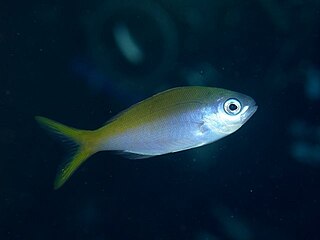
Macolor is a genus of marine ray-finned fish, snappers belonging to the family Lutjanidae. They are native to the Indian Ocean and the western Pacific Ocean.

The black and white snapper, the black and white seaperch or black snapper, is a species of marine ray-finned fish, a snapper belonging to the family Lutjanidae. It is native to the Indian Ocean and the western Pacific Ocean.

The bigeye snapper, also known as the bigeye seaperch, red sea lined snapper, golden striped snapper, rosy snapper, yellow snapper, or simply snapper, is a species of marine ray-finned fish, a snapper belonging to the family Lutjanidae. It is native to the Indian Ocean and the western Pacific Ocean. It is the type species of the genus Lutjanus.

Caesionidae, the fusiliers, are a family of marine ray-finned fishes in the order Perciformes. The family includes about 23 species. They are related to the snappers, but adapted for feeding on plankton, rather than on larger prey. They are found at reefs in the Indo-Pacific and in the Red Sea.

The sailfin snapper, blue-lined sea bream or blue-lined sea perch is a species of marine ray-finned fish, a snapper belonging to the family Lutjanidae. It is native to the Indo-Pacific region. The sailfin snapper is targeted in mixed-species fisheries throughout its range. In areas such as the Philippines it is known to be overfished, while in others, for example Palau, pressure is lighter. It is caught predominantly using handlines and bottom trawling. The juveniles appear in the aquarium trade. It is currently the only known member of its genus.

Lutjanus adetii, the yellow-banded snapper or hussar, is a species of marine ray-finned fish, a snapper belonging to the family Lutjanidae. It is native to the southwestern Pacific Ocean. This species is of minor importance to local commercial fisheries and is sought after as a game fish.

The dark-banded fusilier, also known as blue-streak fusilier, bluedash fusilier, or neon fusilier, is a species of marine ray-finned fish, a fusilier belonging to the family Caesionidae. It has a wide Indo-West Pacific range. It is of some importance to fisheries within its range.

The slender fusilier is a species of marine ray-finned fish, a fusilier belonging to the family Lutjanidae. It is native to tropical reefs in the Indian Ocean and the western Pacific Ocean, it is of minor importance to local commercial fisheries. This species is the only known member of its genus.

Pinjalo is a genus of marine ray-finned fish, snappers belonging to the family Lutjanidae. They are native to the Indian Ocean and the western Pacific Ocean

The Chinamanfish, Chinaman snapper, galloper or thread-finned sea perch, is species of marine ray-finned fish, a snapper belonging to the family Lutjanidae. It is found in the Western Pacific Ocean.

Pterocaesio pisang, the banana fusilier or ruddy fusilier, is a species of marine ray-finned fish, a fusilier belonging to the family Caesionidae. It is widespread around reefs in the Indo-West Pacific region.

Caesio cuning, the redbelly yellowtail fusilier, yellowtail fusilier, red-bellied fusilier or robust fusilier, is a species of marine ray-finned fish, a fusilier belonging to the family Caesionidae. It is native to the Indian and Western Pacific Oceans.

Pristipomoides sieboldii, the lavender jobfish, lavender snapper or von Siebold’s snapper, is a species of ray-finned fish, which is a snapper belonging to the family Lutjanidae. It is found in the Indian and Pacific Oceans.
Pristipomoides flavipinnis, the golden eye jobfish or golden eye snapper, is a species of ray-finned fish, a snapper belonging to the family Lutjanidae. It is found in the Pacific Ocean.

Paracaesio xanthura, the yellowtail blue snapper, the false fusilier, gold-backed fusilier, Pedley's fusilier or Southern fusilier, is a species of marine ray-finned fish, a snapper belonging to the family Lutjanidae. It is native to the Indo-Pacific region.

Lutjanus russellii, Russell's snapper, Moses snapper, fingermark bream, Moses seaperch or Russell's sea-perch, is a species of marine ray-finned fish, a snapper belonging to the family Lutjanidae. It is native to the western Pacific Ocean.

Lutjanus lemniscatus, the yellowstreaked snapper, darktail snapper, darktail seaperch or maroon sea-perch is a species of marine ray-finned fish, a snapper belonging to the family Lutjanidae. It is native to the western Pacific and Indian Oceans.

Etelis carbunculus, the deep-water red snapper, ruby snapper, longtail snapper, or ehu, is a species of ray-finned fish, a snapper belonging to the family Lutjanidae. It is found in the Indo-Pacific region.

Lutjanus endecacanthus, the Guinea snapper, is a species of marine ray-finned fish, a snapper belonging to the family Lutjanidae. It is found on the west coast of Africa in the eastern Atlantic Ocean.
Pinjalo lewisi, the slender pinjalo or red pinjalo, is a species of marine ray-finned fish, a snapper belonging to the family Lutjanidae. It is found in the Indian and Western Pacific Oceans.


















